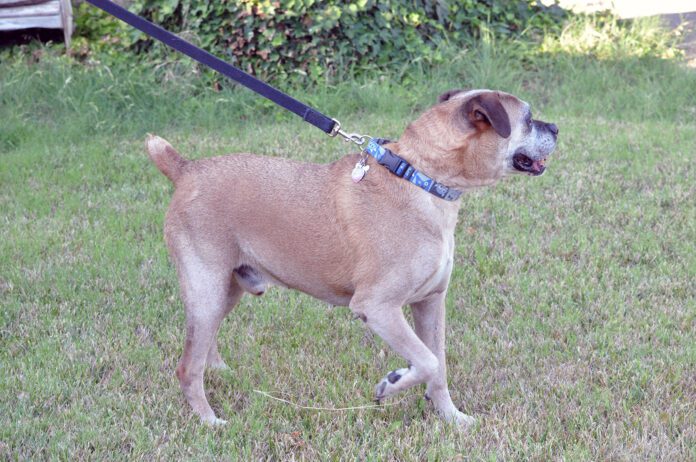
Dogs come in a variety of sizes, shapes, and colors. Each breed has different physical attributes, including the shape and length of the tail. But why do some breeds have long tails while others have short tails? Why are some dogs born with long tails sporting short docked tails later in their lives?
Although some breeds of dogs are born with a naturally bobbed tail (such as the Pembroke Welsh Corgi, Boston Terrier, and Jack Russell Terrier), other dog breeds may have a “docked” tail, where a portion of their tail was removed when they were puppies. It’s a common practice to dock the tails of some dogs – but not without controversy.
How are puppies’ tails docked?
Tail docking is a procedure that is typically done within a puppy’s first five days of life. A portion of the tail may be severed with a pair of scissors or other sharp instrument. Anesthesia is typically not administered and neither is an analgesic. The wound is often left open and not sutured closed.
Puppies can experience pain in their tails, even at such a young age. A study published in 1996 found that puppies will vocalize for more than two minutes following the tail docking procedure and can take up to 15 minutes to settle and go to sleep after their tails have been docked.
Another method is to apply a tight rubber band to the tail in order to occlude the blood supply to the unwanted portion. Once the blood supply is cut off, the skin, muscle, cartilage, bone, blood vessels, and nerves on the caudal (farthest from the head) side of the band will die.
It typically takes several days for the dead end of the tail to separate from the living section of tail, but it can take up to two weeks. A puppy will feel the sensation of pain in his or her tail and the pressure of the rubber band while it is in place.
Complications from Docked Tails
Several complications are possible with tail docking. With the severing method, the open wound can become infected; with the banding method, the dead and necrotic tissue can become infected. The development of a neuroma (a disorganized growth of nerve cells at the site of a nerve injury) is possible with either method. A tail neuroma is a thickening of the stump at the site of the tail amputation. Neuromas are very sensitive and can send searing pain through nearby tissues when even lightly touched.
Tail docking involves the severing of nerves in the tail. Anecdotally, some dogs with docked tails exhibit behaviors (such as aggressively chasing and/or chewing their tails) that may be associated with neuropathic pain. A study published in 2012 examined the development of neuropathic pain in adult rats who had undergone a procedure to injure nerves when the rats were just 10 days old. The researchers found that these rats developed lifelong neuropathic pain associated with the nerve injury but only once the rats reached full maturity. A similar phenomenon has been observed in humans who suffered a traumatic nerve injury as an infant.
Why are dog tails docked?
Tail docking is done for only certain breeds of dogs to meet a breed standard. A breed standard defines the accepted appearance, gait, and temperament of a specific dog breed. Breed standards are created and maintained by kennel clubs, such as the American Kennel Club (AKC) in the United States and the European Kennel Club (EKC) in Europe.
According to the AKC’s website, the breed standard is the breeder’s blueprint to which all dogs of that breed are compared. The breed standard is used by judges of a dog show to determine the best entrants that represent that breed. And it’s not just the dogs that are judged; the breeders are judged by how well they produce dogs that conform to the breed standard.
Dog breeds whose tails must be docked to meet the AKC breed standard include the Doberman Pinscher, German Shorthaired Pointer, and Miniature Schnauzer. The breed standard for the Doberman Pinscher states that the tail must be docked to the second joint; this means that all but the first two vertebra are removed from the tail. For the German Shorthaired Pointer, 60% of the original tail must be removed to meet the breed standard. The Miniature Schnauzer breed standard requires that the tail be docked to the point of just being visible beyond the backline of the body.
Advocates of tail docking usually cite a reduced incidence of tail injuries in working and hunting dogs and improved hind end hygiene in long-haired dogs. A study published in 2010 found that dogs with docked tails were less likely to experience a tail injury. However, it was also found that the incidence of tail injury was so low that 500 dogs would need to have their tails docked to prevent just one tail injury.
It is also interesting to note that while some hunting dog breeds – such as the German Shorthaired Pointer – have their tails docked, other working and hunting breeds – such as the German Shepherd, Labrador Retriever, and German Longhaired Pointer – do not have their tails docked.
Hind-end hygiene is an important issue for dogs, especially for those with long fur. While docking the tail in those breeds will minimize the risk of feces getting stuck in the fur on the underside of the tail, it will not prevent fecal contamination of the fur on the backs of the thighs and, in female dogs, the fur around the vulva. Although the breed standard for some long-haired breeds require that the tail be docked, other long-haired breeds – such as the Collie and Afghan Hound – do not have their tails docked.
Docking is decreasing
While the AKC and many breeders support the practice of tail docking, there are many organizations and people that do not. Most veterinary professional organizations around the world have issued statements that oppose tail docking. In the United States, these organizations include the American Veterinary Medical Association and the American Animal Hospital Association. The Royal Society for the Prevention of Cruelty to Animals in both Australia and the United Kingdom have taken a stand against tail docking.
Tail docking has been banned in several countries around the world, including Australia and most of Europe. The procedure has also been banned in several Canadian provinces, including Newfoundland, Prince Edward Island, and Nova Scotia. A law banning tail docking was recently passed in Quebec and is slated to take effect in February 2024.
In the United States, only the states of Maryland and Pennsylvania restrict the docking of a dog’s tail. Proponents of the passage of these laws cite pain, the potential for short- and long-term complications, and the lack of functional reasons to dock a tail as reasons to ban the procedure except when medically necessary.
Breeders in the United States are not required to dock the tails of puppies in their care. While many breeders dock tails to conform to a breed standard, some breeders choose not to dock their puppies’ tails. When selecting a breeder for a dog breed that traditionally has a docked tail, be sure to inquire about the procedure. Select a breeder that matches your goals and your conscience.
Tail amputation is the surgical removal of part of a dog’s tail for medical reasons. Most commonly, tail amputation is necessary due to a condition known ironically as “happy tail,” which occurs when a dog sustains an open wound on his tail through trauma by wagging. The wound closes but then reopens and bleeds when he wags the tail and smacks it against a hard surface (this is common with overstimulated dogs in shelters with concrete walls). Although the wound can be healed with proper veterinary intervention and management, in rare cases the tail will not heal and must be amputated near the point of the recurring injury.
Crushing injuries to the tail that do not heal and result in necrosis of the injured section typically require amputation of the affected tail portion.
Cancerous tumors can also arise on the tail. Since there is no excess skin on the tail, it is nearly impossible to obtain clean surgical margins by removing only the tumor. Therefore, the portion of the tail containing the tumor is amputated to save the life of the dog.






It’s not uncommon for people to assume that Pembroke Welsh Corgis are born without tails since so many of them are tailless.
However, (most) Pembroke Welsh Corgis are born with long full-length tails nearly identical to Cardigan Welsh Corgi tails.
Pembroke Welsh Corgis (in select countries like the U.S. and Canada) will have their tails docked (removed) shortly after they are born.
In countries that do not allow tail docking, Pembroke Welsh Corgis will keep their full-length tails
https://stumpsandrumps.com/corgi-tails/